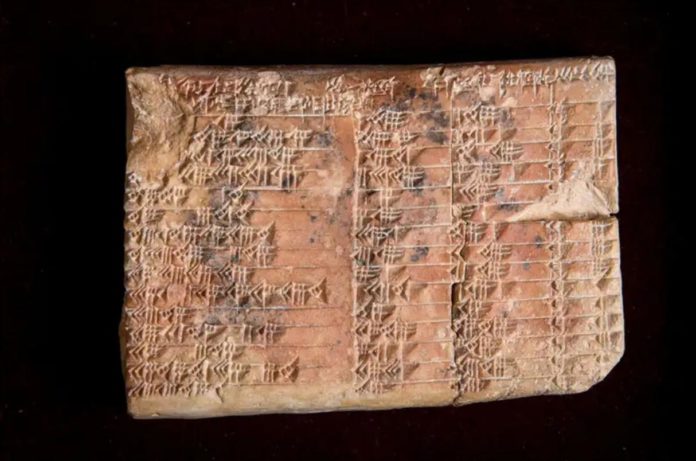The Babylonians knew how to make precise right-angled triangles. They used this mathematical knowledge to divide farmland over 1000 years before the Greek philosopher Pythagoras.
“They’re using a theoretical understanding of objects to do practical things,” according to Daniel Mansfield from the University of New South Wales in Sydney, Australia.
“It’s very strange to see these objects almost 4000 years ago.”
- Brief Anger Hampers Blood Vessel Function Leading to Increased Risk of Heart Disease and Stroke – New Study
- New Blood Test Pinpoints Future Stroke Risk – Study Identifies Inflammatory Molecules as Key Biomarker
- Enceladus: A Potential Haven for Extraterrestrial Life in its Hidden Ocean Depths
- New Experiment: Dark Matter Is Not As ‘DARK’ As All We Think
- Scientists in Fear of This New Predator From Red Sea Eating Native Species in Mediterranean
Babylonia was one of several ancient societies that overlapped in Mesopotamia, a region of southwest Asia located between the Tigris and Euphrates rivers. Between 2500 and 500 BC, Babylonia existed, and the First Babylonian Empire ruled over a large area between 1900 and 1600 BC.
Mansfield has been studying Plimpton 322, a broken clay tablet from this time period. Cuneiform markings cover it, forming a mathematical table listing “Pythagorean triples”.
Each triple is the lengths of the three sides of a right-angled triangle, where each side is a whole number. The simplest example is (3, 4, 5); others include (5, 12, 13) and (8, 15, 17).
‘The lengths of the triangles’ sides are determined by Pythagoras’ theorem, which states that the square of the longest side equals the sum of the squares of the other two sides. Pythagoras was a Greek philosopher who lived between 570 and 495 BC, long after the Plimpton 322 tablet was created.
“They [the early Babylonians] knew Pythagoras’ theorem,” says Mansfield. “The question is why?”
Mansfield believes he has discovered the solution. A second clay tablet, dubbed Si.427, discovered in Iraq in 1894 provided the key clue. Mansfield discovered it in Istanbul’s Archaeology Museums.
Si.427 was a surveyor’s tablet, used to perform the calculations required to divide a plot of land into rectangles in a fair manner. Mansfield explains, “the rectangles are always a bit wonky because they’re just approximate”. But Si.427 is different. “The rectangles are perfect,” he says. Pythagorean triples were used by the surveyor to accomplish this.
Mansfield further explains:
“Even the shapes of these tablets tell a story.”
“Si.427 is a hand tablet… Someone’s picked up a piece of clay, stuck it in their hand and wrote on it while surveying a field.”
Plimpton 322, on the other hand, appears to be more of an academic text: a systematic investigation of Pythagorean triples, perhaps inspired by surveyors’ difficulties.
- Brief Anger Hampers Blood Vessel Function Leading to Increased Risk of Heart Disease and Stroke – New Study
- New Blood Test Pinpoints Future Stroke Risk – Study Identifies Inflammatory Molecules as Key Biomarker
- Enceladus: A Potential Haven for Extraterrestrial Life in its Hidden Ocean Depths
- New Experiment: Dark Matter Is Not As ‘DARK’ As All We Think
- Scientists in Fear of This New Predator From Red Sea Eating Native Species in Mediterranean
“Someone’s got a huge slab of clay… [and] squashed it flat” while sitting at a desk, he says.
Journal reference: Foundations of Science, DOI: 10.1007/s10699-021-09806-0
Image: The Plimpton 322 tablet by Andrew Kelly/Rare Books and Manuscripts Library, Columbia University
